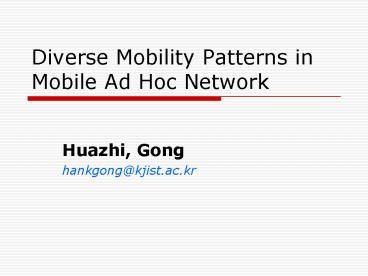Diverse Mobility Patterns in Mobile Ad Hoc Network - PowerPoint PPT Presentation
1 / 17
Title:
Diverse Mobility Patterns in Mobile Ad Hoc Network
Description:
Do not rely on any existing infrastructure. Routes between mobile nodes are typically multi-hop ... random models insufficient to reflect the environmental constraints ... – PowerPoint PPT presentation
Number of Views:36
Avg rating:3.0/5.0
Title: Diverse Mobility Patterns in Mobile Ad Hoc Network
1
Diverse Mobility Patterns in Mobile Ad Hoc Network
- Huazhi, Gong
- hankgong_at_kjist.ac.kr
2
Introduction
- Mobile Ad Hoc Networks (MANETs)
- Formed by wireless mobile nodes
- Do not rely on any existing infrastructure
- Routes between mobile nodes are typically
multi-hop - Network topology can be highly dynamic
- Ad hoc routing protocols
- Reactive protocols AODV, DSR
- Proactive protocols DSDV
- Hybrid protocols ZRP
3
Mobility Models
mobility model
random model
deterministic model
hybrid model
movement bounded by environmental constraints
arbitrary movement without constraints
predefined movement path or real mobility trace
4
Motivation
- most of MANET simulations based on random
mobility models, e.g. random waypoint model
- random models insufficient to reflect the
environmental constraints - deterministic mobility models too complex and
real user traces hard to obtain
? In some real situation, we need hybrid model
such as RPGM
5
RPGM
- Reference Point Group Mobility Model
- Logical relationship between nodes
- Group motion represented by virtual center
- Motion of reference point
- Relative random motion around reference point
? GM1
Parameters Angle Deviation Ratio(ADR) and Speed
Deviation Ratio(SDR), number of groups, max
velocity Vmax.
6
Parameterized Mobility Model
- Freeway Model (FW)
- Each mobile node is restricted to its lane on the
freeway - The velocity of mobile node is temporally
dependent on its previous velocity - If two mobile nodes on the same freeway lane are
within the Safety Distance (SD), the velocity of
the following node cannot exceed the velocity of
preceding node - Parameter Map layout, Vmax
- Manhattan Model (MH)
- Similar to Freeway model, but it allows node to
make turns at each corner of street - Parameter Map layout, Vmax
Map for FW
Map for MH
7
Performance Metrics
- Relative Speed (mobility metric I)
- The magnitude of relative speed of two nodes,
average over all neighborhood pairs and all time - Spatial Dependence (mobility metric II)
- The value of extent of similarity of the
velocities of two nodes that are not too far
apart, average over all neighborhood pairs and
all time
- Average link duration (connectivity metric I)
- The value of link duration, average over all
nodes pairs
8
Mobility Metrics
- Objective
- validate whether proposed mobility models span
the mobility space we explore - Relative speed
- For same Vmax, MH/FW is higher than RWP, which is
higher than SG/MG - Spatial dependence
- For SG/MG, strong degree of spatial dependence
- For RWP/FW/MH, no obvious spatial dependence is
observed
Relative Speed
Spatial Dependence
9
Connectivity Graph Metrics
- Link duration
- For same Vmax, SG/MG is higher than RWP, which is
higher than FW, which is higher than MH - Summary
- Freeway and Manhattan model exhibits a high
relative speed - Spatial Dependence for group mobility is high,
while it is low for random waypoint and other
models - Link Duration for group mobility is higher than
Freeway, Manhattan and random waypoint
Link duration
10
Performance Comparison
- Performance of routing protocols may vary
drastically across mobility patterns - Eg DSR
- There is a difference of 40 for throughput and
an order of magnitude difference for routing
overhead by mobility models!
Throughput
Routing Overhead
11
Throughput vs. Protocols
- We observe that using different mobility models
may alter the ranking of protocols in terms of
the throughput!
Manhattan AODV or DSR?
Random Waypoint DSR?
12
Overhead vs. Protocols
- We observe that using different mobility models
may alter the ranking of protocols in terms of
the routing overhead! - Conclusion Mobility DOES matter, significantly,
in evaluation of protocol performance and in
comparison of various protocols!
RPGM(single group) DSR?
Manhattan DSDV?
13
Analysis of the results
- Recall If mobility affects protocol performance,
why? - We observe a very clear trend between mobility
metric, connectivity and performance - With similar average spatial dependency
- Relative Speed increases? Link Duration
decreases? Routing Overhead increases and
throughput decreases - With similar average relative speed
- Spatial Dependence increase ?Link Duration
increases?Throughput increases and routing
overhead decreases - Conclusion Mobility Metrics influence
Connectivity Metrics which in turn influence
protocol performance metrics !
14
Put all the pieces together
Throughput
Relative Velocity
Link Duration
Spatial Dependence
Overhead
15
Conclusion
- Researched protocol independent metrics to
capture a few mobility characteristics of
interest and compared a rich set of mobility
models - Evaluated protocols over mobility models that
span the above mobility characteristics - Performance trends and comparison results vary
widely with the choice of mobility - Understood the logical relationship between
mobility and protocol performance - Mobility patterns are IMPORTANT
16
Future Work
- To extend mobility pattern to multicast
protocols. - MAODV
- Geocast Protocols
- To analyze the reason of effect of diverse
mobility pattern
17
Reference
- 1 N.Sadagopan, F.Bai, B.Krishnamachari,
A.Helmy, PATHS analysis of PATH duration
Statistics and their impact on reactive MANET
routing protocols MobiHoc 2003. - 2 F.Bai, N.Sadagopan, A.Helmy, BRICS A
Building-block approach for analyzing RoutIng
protoCols in ad hoc networkS- a case study of
reactive routing protocols, USC-CS-TR-02-775, in
submission. - 3 http//www-scf.usc.edu/fbai/mobility.html































